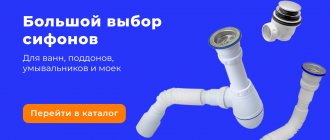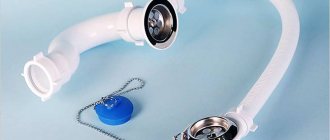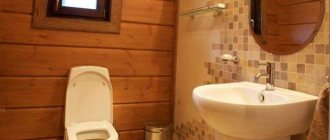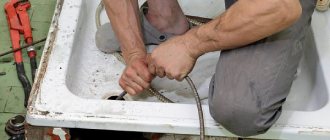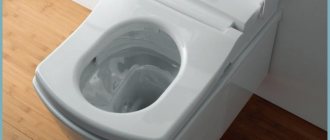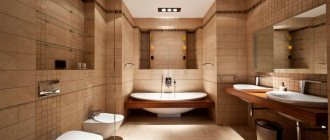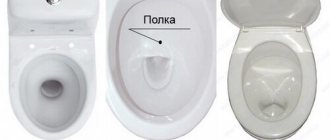Anyone who has been involved in arranging a room for water procedures on their own knows how many little things and additional accessories have to be purchased for this relatively small room. In addition to faucets, a washbasin and the water tank itself, it is very important not to forget and buy a high-quality, perhaps even automatic drain, overflow for the bathtub. What is it, what is the purpose of this design and what selection criteria are the main ones when purchasing it - let’s try to figure it out together.
Basic device
What do you need to start from to understand what kind of device this is? Everyone has known since Soviet times a siphon with a rubber stopper on a metal chain. This is what the basic model of the drain-overflow design looks like. Progress in the production of sanitary ware does not stand still. Today, even this design has undergone changes.
To drain the water, you no longer need to bend over and pull out the plug. The bathroom drain has become automated. There are a variety of device types available for sale. The drain-overflow system is often sold together with the bathtub. Masters advise choosing it yourself.
First we choose the design of the siphon for the bathroom, and then the design
The familiar one is gradually disappearing from our homes, since modern devices allow us to open the water drain with one movement, rather than pulling out a rubber stopper by a chain. Especially when the bathtub is filled with hot water and the plug is firmly in place. Agree, this is very convenient. Therefore, we will not consider the familiar design of pulling out the cork. Let's focus on those that are the future. Of course, indicating the pros and cons of each device (after all, this is what the “Tips from an Experienced Plumber” blog is for). Today in plumbing stores
Description of the drain-overflow mechanism
The function of the device is to drain liquid from the font into the sewer pipe. The entire system consists of interconnected hoses and tubes that are connected to two holes in the bowl and a sewer. The hole at the top on the wall of the bath prevents liquid from overflowing, the hole at the bottom is for draining liquid.
If the structure is installed correctly, then overfilling the tank is basically impossible. You can arrange it later if the speed at which the bowl fills with water is greater than it comes out.
What are drain systems made of?
How to assemble a bath siphon: installation features
In the production of devices, materials are used that are resistant to corrosion, alkaline and acidic substances, and hot water. In the last century, when the range of plumbing equipment was quite narrow, drainage systems were made mainly of ferrous metal.
Although this material quickly loses its original aesthetics, it serves well for a long time, bravely withstanding high pressure and temperature changes. Despite its advantages, now manufacturers still give preference to non-ferrous metals and plastic.
Plastic harnesses are attractive at an affordable price. They are appropriate in bathtubs equipped with a decorative screen. Their universal dimensions adapt to non-standard sewer outlets and drains.
Plastic products are light in weight, easy to assemble, and do not undergo deformation due to the interaction of moisture and impurities contained in it
Metal objects are significantly ahead of plastic in terms of strength, service life and design. The most common products are made of brass, bronze, and copper. Chromium or nickel is applied to the drain grids and certain parts in them using electroplating techniques.
Provided that the devices are cleaned in a timely manner and the washer joints are disassembled, unlike plastic, they are unlikely to fail even after decades.
You can understand what kind of metal the structure is made of by carefully examining the pipe connecting the drain and overflow holes. Copper is recognizable by its reddish tint, ductility and softness. Brass is a durable yellow alloy of zinc and copper. Bronze is a fairly hard, dark brown material containing copper and tin.
Bronze and brass trims look great in classic and retro interiors. They look very elegant and neat, which is especially valuable when the bathtub is in the center of the room
Classification of types of drain mechanism
Three types of devices are considered and each has its own design features.
Standard type device
This simplest design is represented by components:
- a siphon is represented by a pipe. It stops the penetration of unpleasant odors into the room;
- drain hole for overflow;
- liquid outlet hole at the bottom of the bowl;
- connecting tube for siphon and sewer pipe;
- The liquid is poured through a corrugated pipe into the siphon.
The mechanism is called traditional. When the drain neck is closed with a stopper, water is drawn into the tank.
Operational problems may arise with rubber gaskets. They change periodically. The price of a standard mechanism is 10-25 dollars.
It is classified as a reliable mechanism, since there are no moving elements in its design. The simple drain design is easy to assemble and install yourself.
Differences between automatic and semi-automatic mechanisms
Structurally, the drainage mechanism for the bathtub is designed in two types:
- automatic bath drain;
- semi-automatic in the bathroom.
Automatic bath drain
The device is also called “click-click”. The system works very simply. At the bottom of the bowl there is a button that starts the automatic siphon. The first press of the button opens the drain, the second press closes it. The operation of the mechanism depends on the spring that is attached to the system plug.
Features of a bath drain
Bathtub overflow
The drain-overflow is a structure consisting of a siphon and an overflow hole, which is connected by a tube. The siphon performs its standard function - it prevents unpleasant odors from the sewer from entering the room, and the overflow hole prevents the bath from overflowing and flooding.
The structure consists of the following parts:
- Drain neck - installed where the lower hole in the bathtub body is located. Structurally, there are two elements. They are pressed against the inner and outer surfaces; additional tightness is provided by rubber gaskets. The upper part – decorative – is made of chromed metal. The lower part is a pipe with a built-in nut. They are connected to each other using a metal screw.
- Overflow neck - from the side of the bathtub it is similar to the drain, but is installed where the top hole is located. When the water reaches the overflow hole, it begins to drain into the siphon. But the overflow is not able to completely protect against flooding, since the overflow pipe has a small diameter and with high pressure, the bath fills faster than the water drains.
- Siphon. There is a curved section that acts as a water seal. There is always water in it, blocking access to unpleasant odors from the sewer. Problems can arise due to errors in the design of the sewer system. In this case, the small volume water seal is broken by the vacuum formed in the system. Just in case, it is recommended to purchase a harness with a volume of about 400 ml.
- Connecting pipe. This is usually a corrugated hose that can be stretched or compressed, depending on the distance between the overflow and drain holes. The pipe attachment assembly can be crimped or not. In expensive models, sealing gaskets are additionally installed.
- Pipe for connection to the apartment sewerage system. It can be corrugated and hard. The first one is easier to connect, but the second one is more reliable in operation and more durable.
Additionally, the design is equipped with conical and flat sealing gaskets.
There are only 4 types of harness designs:
- traditional siphon with stopper;
- semi-automatic;
- machine;
- automatic machine with filling mode.
The traditional siphon has the simplest design, and therefore the lowest cost.
Classic: simplicity and reliability
Classic design
There are no moving parts or levers in a traditional drain and overflow. The main parts correspond to the design discussed above and are complemented by a stopper, which is attached to the overflow grill using a chain. She plugs the drain hole. Breakdowns are reduced to wear of the sealing gaskets.
Advantages:
- low cost;
- easy installation;
- reliability;
- resistance to breakage.
Flaws:
- fragility of sealing parts.
The assembly and installation of the classic bath frame is simplified as much as possible thanks to its simple design.
Semi-automatic design
Semi-automatic device
Behind the ease of use of the semi-automatic bathtub flush and overflow lies a complex system with a control lever. In addition to the main parts, the package includes a shut-off valve, which is controlled by a lever. The lever itself is:
- decorative handle;
- valve;
- button;
- swivel ring.
When the lever is pressed, the rod rises and the shut-off valve opens. When turned in the opposite direction, the rod lowers and the drain hole is sealed. The device operates by tensioning and loosening a cable, which can be installed inside or outside the overflow. The first option is more aesthetically pleasing, but more difficult to install.
Advantages:
- The overflow hole is not visible because it is masked by the control element.
- To seal the drain, you don't have to reach down to the bottom of the bathtub.
- Compactness.
- Varied design.
Flaws:
- high price;
- low reliability of the spring and shut-off valve;
- complex repair.
Thanks to the variety of design options, you can choose a semi-automatic drain for a bathroom with any design: high-tech, retro, modern. Characteristic style features are provided by shape, color, and materials.
Advantages of an automatic mechanism
Automatic mechanism
From an operational point of view, this system is the simplest. Control is carried out using a click-clack valve. No additional levers or plugs are required. It is convenient to press the valve with your heel while standing in the bath, thus sealing the hole. When pressed again, the valve opens.
Disadvantages of automatic bath drain:
- High price. The price of automatic devices can be several times higher than the cost of mechanical siphons.
- Breakdowns. Due to the complexity of the mechanism and insufficient quality materials, automatic systems quickly fail. Therefore, it is recommended to choose devices from well-known manufacturers.
- It is inconvenient to turn off the water. You have to bend over to manually press the valve.
If the spring that operates the valve fails, the entire structure will have to be replaced.
Automatic drain with water supply
The difference is that this system, unlike a conventional machine, is supplemented with pipes that supply water to the overflow hole. When the water reaches the hole, the filling stops automatically. These are expensive systems, the cost of which is several times higher than other designs. For example, the Grohe Talentofill model for standard bathtubs (28,990,000) costs more than 8 thousand rubles.
Installation of bath trim
Installation of the system begins only after the position of the bath is fixed. It is set according to level and height. This is especially true for products made of acrylic and metal, since they are unstable due to their light construction.
It is not recommended to completely cover the bathtub structure with facing material without an inspection hatch. It will provide quick access to the drain system in an emergency.
There are general recommendations for installing an automatic and semi-automatic bath overflow drain system:
- After installation, a distance of 15 cm is maintained between the base of the siphon and the floor covering.
- The tee hole is connected to the grille at the drain hole.
- A rubber gasket is installed at the time of connection.
- The siphon is connected to the outlet from the tee using a nut.
- The pipe is fixed on the side at the branch of the tee.
- The siphon is connected to the sewer.
- Each part of the device is sealed.
The work completed is checked. To do this, the tank is filled with water. A dry cloth is spread on the floor so that drops of water are visible if the system is not installed properly. A hole opens and the liquid flows down the drain system.
↑ 3. Types and features of materials
The main condition when choosing a material is corrosion resistance. These options include:
- Ferrous metal is a reliable material. The main drawback is the appearance of the device. Currently, they are trying to choose more modern options;
- Plastic for plumbing fixtures (polypropylene). White color, laconic shape, long service life. Polypropylene is inferior to metal in terms of strength, so there is a risk of product breakage. A simple drain and overflow design may be inappropriate if the decoration of the room involves the use of expensive materials and equipment;
- Bronze, brass or copper. Often these non-ferrous metals are not used without a protective layer. Parts located in the visible area can be coated with nickel or chromium (using the electroplating method). The use of nickel is preferable; this material is characterized by long-term operation. The visual difference of nickel is the blue tint of the parts;
In order to determine the type of metal, you should pay attention to the holes in the top and bottom of the bath. The color of copper is red; the strength characteristics of copper are inferior to other materials. Brass is stronger than copper and has a light yellow tint. The bronze base is the most durable in this category, comparable in stability to ferrous metal. Bronze is characterized by a dark brown tone; the main components of the alloy are zinc and copper. Non-ferrous metals are an excellent option for the production of plumbing fixtures. Due to the resistance to corrosion, the parts are easily connected by thread.
Be careful not to damage the protective coating of the base. Even a small scratch will cause the destruction of the entire layer in the shortest possible time. The reason for this effect is a chemical process between metals.
Manufacturers rating
- The automatic model of the Kaiser brand, produced in Germany, has won a leading position in the Russian market. The price of the structure is up to 3.0 thousand rubles.
- For buyers with average incomes, systems from the Viega and Geberit brands are offered. In terms of build quality, Geberit is inferior to Viega.
- Semi-automatic drain-overflow systems from the Abelone brand are in demand on the plumbing market. The automatic mechanism of this company can withstand 50 thousand operating cycles (the mechanism opens and closes). It is made of copper, various coatings are applied. Machine price: 3.2 – 3.5 thousand rubles.
- If you don’t want to spend money on bathtub drainage systems, then Frap brand models are ideal. The company produces budget and luxury devices. Their price: 1.0 – 3.0 thousand rubles.
- Easy to install Equation brand models. The company produces a system for both bathtubs and washbasins. Most models are made of plastic.
What types are there?
There are not many varieties of this product based on the way it works. There are 3 types in total, which are completely different from each other:
- Mechanical systems;
- Semi-automatic;
- Automatic.
The name of each system is conditional. It reveals only the operating principle that occurs inside the equipment; automatic systems do not have any special features that allow control via a smartphone
To make it easier to navigate the store, it is important to know what the main differences between representatives
Mechanical option
Open overflow neck and drain hole, which is closed with a lid. Here are the main features of the equipment. The upper part can be covered with a decorative element. This does not make the throughput any worse. All functions work perfectly.
To close the bottom drain, the kit includes a special cover, which is made of plastic or metal, but has a rubberized part that ensures a tight fit. For greater convenience, some manufacturers equip the element with a chain; it allows you to quickly find the plug under water.
In many bathrooms, the mechanical product is in high demand. Because the bath itself has a long service life and is rarely changed. Of course, the product cannot provide any special features, and all actions are reduced to manual control, but its reliability has been proven over the years.
Advantages:
- Low price of equipment;
- Easy installation;
- Good durability indicator;
- Reliability.
There are disadvantages, not many of them, so most of them are conditional:
- An outdated option that is not suitable for lovers of modern solutions;
- Sometimes the plug can get lost, especially if there is a child in the apartment.
Semi-automatic devices
A modern option that features additional functionality and an affordable price. The equipment is equipped with special elements that increase operating comfort. The design of this device is much more complex, so installation work is recommended to be carried out by plumbers.
Advantages of execution:
- Convenient adjustment of the water level; a person does not need to come into contact with the water to find the plug; just turn the lever or press the button located on the overflow neck.
- Beautiful external design that stands out from the general background.
Flaws:
- If the user uses the drain hole control device several times a day, the cable will quickly become unusable and begin to work incorrectly.
- It is not recommended to install the structure in apartments where hard water flows through the water supply, because plaque will begin to form on the main elements. This will cause the equipment to break down after a couple of years of use.
Due to the fact that the system is equipped with a rotating element, this is its weak point. Therefore, the following problems occur:
- Cable breakage due to severe wear;
- Damage to the drain element;
- Flywheel failure.
There are many options for the formation of problems, so when choosing this product, attention is paid to the manufacturer and material. Everything must be manufactured at the highest level so that unexpected malfunctions do not occur.
It is advisable to provide a long warranty. We also must not forget about proper operation; compliance with these rules often extends the service life by 2 times.
Automatic equipment
Of course, there is no complete automation in this product; all actions are performed using mechanical forces, as in the previous version. There are also differences, for example, to open or close, an intermediate element, for example, a cable, is not used, all actions are performed directly. This mechanism is located in the drain neck.
- Ease of use;
- Beautiful appearance;
- There are practically no breakdowns, since there are no transmission mechanisms.
Despite the positive aspects, such equipment also has disadvantages:
- To descend from a bathtub where there is a large amount of water, you will have to dip your hand in the liquid and press the corresponding button;
- If the valve fails, a person will have to buy a new model, since the product cannot be repaired;
- Sometimes there are breakdowns of the latch where a spring is used. However, this element can be replaced, the main thing is to use the same model.
- Low bandwidth.
Care Tips
There are no strict rules for operating the drain and overflow. Let's look at some tips for caring for this system:
- For automatic and semi-automatic devices, it is necessary to periodically process the parts to maintain the shine of the metal. Such care is carried out using glass cleaners or special products;
- Carry out regular inspections to identify possible leaks;
- If the seal is broken, you can replace the sealing material, or tighten the junction of the elements additionally;
- Siphon clogging is considered one of the most common problems in the operation of this system. Cleaning is carried out with a small brush attached to a wire or using a plunger;
- An alternative to mechanical cleaning is chemical treatment using special means. The alkali in such products helps neutralize the blockage due to its splitting effect;
- These measures can be applied not only to the problem of blockage. The best way to prevent such a problem is periodic maintenance of the system.
What to look for when choosing a siphon
How to choose a siphon for a sink:
- study the specifics of the sink. A siphon must be included with the sink if the size of its drain does not meet the usual standards. Otherwise, there should be no problems finding the siphon;
- Don't forget about the required bandwidth. If, in addition to washing, additional equipment will be connected with the need to drain water, care should be taken to increase the throughput. This can be done by increasing the cross-section of the pipe or the number of outlets to the sewer. It should be remembered that a corrugated siphon is not suitable for connecting additional drains of household appliances to it;
- The choice of siphon is also influenced by the location of the inlet sewer pipe. If the location is low, choosing a pipe siphon will require additional costs from you to raise the pipe to the required level. An option to solve the problem may be to choose a corrugated siphon;
- It is necessary to take into account the amount of free space under the sink. Sink siphons come in various sizes and, if one of them fits you, the other may simply not have enough space;
- When purchasing, be sure to identify possible defective parts. You can disassemble the device and carefully inspect the threaded connections for chips and burrs that could damage the seals. If the quality of the rubber gaskets leaves much to be desired, you need to take care of purchasing a set of more reliable seals;
- and the most important thing for the consumer is always the aesthetic characteristics of the product. And here everything will depend solely on your preferences. Currently, many siphons are produced for sinks of various shapes and sizes, but their reliability and strength are at the same level.
Corrugated siphon
It's no secret that in comparison with analogues, this type of device has a simplified design. It is a corrugated pipe with a curved frame at the outlet. One side of the siphon is connected directly to the drain hole of the sink, and the other is equipped with a special adapter that connects the sewer system and the device itself to each other.
Main advantages:
- simplicity of design;
- ease of installation;
- possibility of installation by yourself;
- Possibility of installation in limited space;
- the ability to move the sink from one position to another without the need to disconnect.
Main disadvantages:
- contamination of siphon folds with dirt, debris and grease;
- difficulty in cleaning up contamination;
- The need to dismantle the siphon for cleaning or to carry it out using chemicals.
Pipe siphon
This species has almost no distinctive features. This is a regular pipe, bent in the shape of an S or U. The presence of a hole in the bottom allows for cleaning. The rigid connection of the structural elements does not allow bending the siphon for ease of assembly.
Main advantages:
- compact design;
- attractive appearance;
Pipe siphon - protection from fetid sewer odor;
- ease of cleaning, possible if a cleaning hole is made in the lower part;
- the need to make an entrance to the sewer at a certain distance.
Main disadvantages:
- more difficult installation compared to other types due to the rigid connection of the elements;
- rapid formation of blockages (not recommended for installation in the kitchen);
- Due to the shallow water seal, infrequent use increases the likelihood of water evaporation, which can cause a foul odor from the sewer. When leaving home for a long period of time, it is recommended to close the drain with a plug.
Installing a siphon: select the material and assemble it yourself
Pressing the bulb several times is not difficult, but replacing the batteries in the siphon is an additional headache. And what happens if the electric motor still breaks down....
Battery-powered siphon with mechanical filter
The siphon is not used to clean the aquarium only if the aquarium is completely planted. Firstly, I can't imagine how you could siphon, for example, Himianthus cubes or Eleocharis.
This will inevitably lead to damage to the aquarium plants. Secondly, all sediment accumulated in the soil is food for aquarium plants. I haven't dumped the soil in years, the floors were completely dirty, but now I feel like there will be a root in my soil.
But still, if there are areas in the aquarium where plants do not grow siphonically, soil is necessary.
The soil exceeds the number of fish in the aquarium: from once a week to once a month. The soil siphon is suitable for combination with partial water changes - 20% of the sediment is dried, 20% of fresh water is added.
It is not difficult to make a siphon for cleaning an aquarium with your own hands. For this you need a hose and a plastic bottle.
We cut off the bottom of the bottle and connected the door to the tube. It is not easy to secure the pumping bulb, so the pipe must be removed to create a reverse draft. But, in my opinion, a siphon for an aquarium is not equipment that is worth saving less than 100 rubles. It's better to buy ready-made, cheap ones, and you'll be served for years.
Internal siphon
When choosing a siphon, it is necessary to take into account the diameter of the pipe; the larger the diameter of the pipe, the greater the pressure of the water flow.
And if you have a tank with a volume of 20 liters, then you do not have time to cover the entire earth faster than combining all the water in the aquarium :). A 100-liter aquarium fits well into the diameter of the pipe in centimeters. The siphon process alone will collect about 20 percent of the water needed for a water change.
Connection dimensions
The connecting dimensions of the sewer pipes are 32, 40 and 50 mm. Before purchasing a bathtub siphon, you will need to measure the diameter of the old drain. It is recommended to take a new one with the same fit. If a suitable siphon of the required size is not available, you will need to purchase a transition collar. A siphon for bathtubs with a stepped drain end is available for sale in all 3 sizes. The excess can be cut off. In this case, the lower seal must be purchased separately.
In the last two cases, you will need to purchase a sealing collar at the moment when the siphon is in your hands, in order to check how it fits on the drain, how strong and elastic it is. Do not choose a siphon with large burrs on the drain edge.
